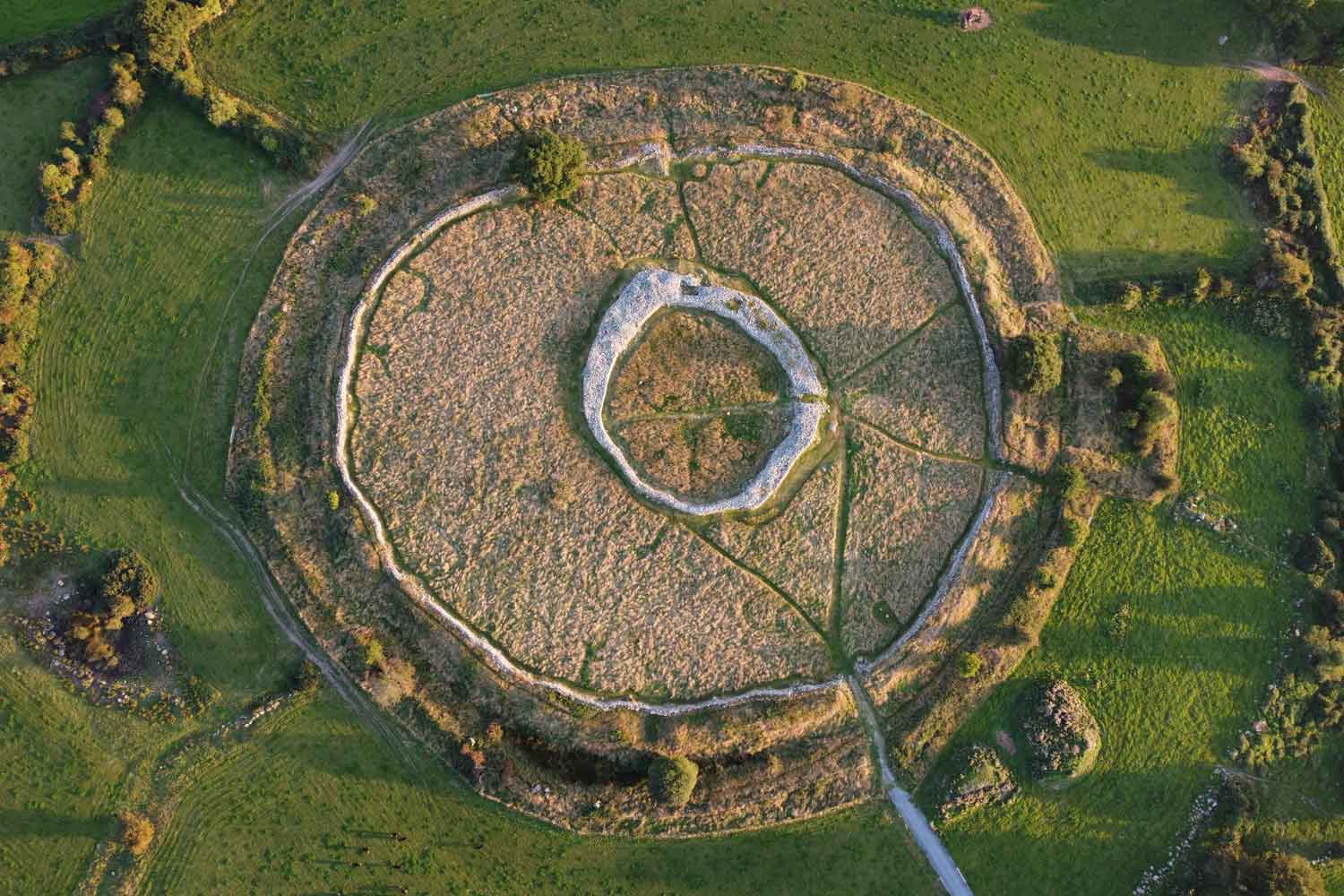Rathgall

Location: Rath East, Co. Wicklow
Classification: Hillfort
SMR Code: WI037-016----
Rating:
Rathgall Hillfort, also known as the 'Ring of the Rath' is located near the village of Shillelagh in Co. Wicklow. It is one of the largest and most impressive hillforts in Ireland. Rathgall consists of three concentric stone ramparts which may have been built in different phases, beginning in the late Neolithic. The outer rampart encloses an area of some 7.5 hectares (18 acres - over 70,000 sq metres). Within this enclosure are two closely spaced ramparts separated by a deep ditch, similar to a henge, with an inner diameter of c.130m. At the centre of this immense structure is the rath itself, an early Medieval ring-fort with a diameter of c.45 metres which surrounds yet another prehistoric ring-ditch.
Although its usage spans millennia, Rathgall reached its peak of activity during the mid to late Bronze Age 1500-800BCE and in terms of artefacts, is one of the richest sites known from this period. Jet and lignite bracelets, glass beads, amber, gold and stone objects were found as well as a small gold-plated copper ring, approximately 1 cm wide, embedded in a cremated baby's bones. The remains of a female and child in a foetal position were also discovered in a clay pot buried beneath some large stone slabs, surrounded by wooden post-holes. These burials indicate a ritual element to the site, beyond any defensive or domestic use. Extensive metal workshop areas were also uncovered at the site, along with hundreds of clay moulds for making bronze swords, spearheads and tools. The discovery of an iron-smelting furnace indicates that Rathgall was also occupied during the iron age. The use of the site for the manufacture of metal weapons ties in with one of the most enduring legends associated with Rathgall.
Rathgall is said to have been the residence of Labraid Loingsech (Labraid the Exile). A mythical High King of Ireland, Labraid is thought to have been an ancestor deity of the Laigin; the tribe who gave their name to the province of Leinster. Although Rathgall was finally abandoned in the 13th century AD, its survival in such good condition may be in part due to the belief, in early-modern times, the fort was occupied by the Aos Sí (faeries). Local stories tell of the faeries playing music at the fort and engaging in moonlit fox-hunts; cows becoming enchanted and no longer giving milk as the faeries were using them to suckle their own pigs. One tale of a local girl who wandered into the fort, tells that she was taken by the faeries, who sent one of their own kind, in disguise, back to live with her family. Despite such tales, Rathgall became a site of pilgrimage for childless couples or single men and women, looking to marry, right up until the early 20th Century.
Description
Rathgall Hillfort, also known as the 'Ring of the Rath' is located near the village of Shillelagh in Co. Wicklow. It is one of the largest and most impressive hillforts in Ireland. Rathgall consists of three concentric stone ramparts which may have been built in different phases, beginning in the late Neolithic. The outer rampart encloses an area of some 7.5 hectares (18 acres - over 70,000 sq metres). Within this enclosure are two closely spaced ramparts separated by a deep ditch, similar to a henge, with an inner diameter of c.130m. At the centre of this immense structure is the rath itself, an early Medieval ring-fort with a diameter of c.45 metres which surrounds yet another prehistoric ring-ditch.
History
Although its usage spans millennia, Rathgall reached its peak of activity during the mid to late Bronze Age 1500-800BCE and in terms of artefacts, is one of the richest sites known from this period. Jet and lignite bracelets, glass beads, amber, gold and stone objects were found as well as a small gold-plated copper ring, approximately 1 cm wide, embedded in a cremated baby's bones. The remains of a female and child in a foetal position were also discovered in a clay pot buried beneath some large stone slabs, surrounded by wooden post-holes. These burials indicate a ritual element to the site, beyond any defensive or domestic use. Extensive metal workshop areas were also uncovered at the site, along with hundreds of clay moulds for making bronze swords, spearheads and tools. The discovery of an iron-smelting furnace indicates that Rathgall was also occupied during the iron age. The use of the site for the manufacture of metal weapons ties in with one of the most enduring legends associated with Rathgall.
Folklore
Rathgall is said to have been the residence of Labraid Loingsech (Labraid the Exile). A mythical High King of Ireland, Labraid is thought to have been an ancestor deity of the Laigin; the tribe who gave their name to the province of Leinster. Although Rathgall was finally abandoned in the 13th century AD, its survival in such good condition may be in part due to the belief, in early-modern times, the fort was occupied by the Aos Sí (faeries). Local stories tell of the faeries playing music at the fort and engaging in moonlit fox-hunts; cows becoming enchanted and no longer giving milk as the faeries were using them to suckle their own pigs. One tale of a local girl who wandered into the fort, tells that she was taken by the faeries, who sent one of their own kind, in disguise, back to live with her family. Despite such tales, Rathgall became a site of pilgrimage for childless couples or single men and women, looking to marry, right up until the early 20th Century.
Accessibility Rating: Easy
Carpark
Accessibility
Accessibility Class: Easy
Facilities
Carpark
Map
Users should note that the Monumental Ireland application and website are information guides only and do not act as an invitation to enter any of the properties or sites listed. No responsibility is accepted by the creators of the Monumental Ireland application for any loss, injury or inconveniences sustained as a result of using it.





